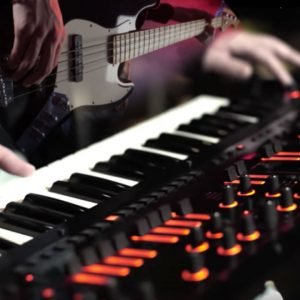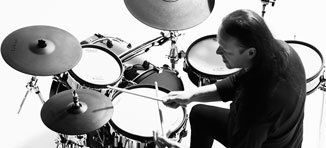The terms used in the synthesizer world can be very confusing – especially for a beginner… what is ADSR, envelope, oscillator???
Opening up a manual, it would be easy to think that it was written in a completely different language! No matter what level of “synthesist” you are, this A-to-Z of Synthesizer Terms is a resource you can use to translate the language of the synth.
QUICK LINKS I A B C D E F G H I J K L M N O P Q R S T U V W X Y Z
A
ADDRESS – A location in the MEMORY where a particular piece of DATA is stored.
ADDITIVE SYNTHESIS – The opposite to SUBTRACTIVE SYNTHESIS. This synthesis involves combining several WAVEFORMS to the main OSCILLATOR to create complex sounds. E.g. Roland SH-3a

ADSR – Abbreviation for “ATTACK/DECAY/SUSTAIN/RELEASE,” the four stages of a traditional ENVELOPE.
AFTERTOUCH – Aftertouch is a type of pressure measured by how hard you press a key/s on a KEYBOARD after the initial ATTACK. This measurement is applied to effects like VIBRATO by pressing harder on the keys.
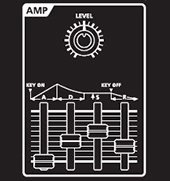
AMPLITUDE – The technical term for a signal’s volume or loudness.
AMPLITUDE MODULATION (A.M.) – The changing of the AMPLITUDE level by a control signal.
AMPLIFIER – A circuit that increases the output power (gain) of a signal. Used to boost low levels to audible range, to add gain to a signal to produce “overdrive” or “distortion” effects or to reduce a loud signal to non-distorted levels.
ANALOG or ANALOGUE – In synthesis terms, analog refers to the production of sound waves using VOLTAGE controlled circuits. These circuits have components that take a physical action (pressing a key) and convert it to a sound source via OSCILLATORS, FILTERS, ENVELOPES and AMPLIFIERS. These components and circuits add a distinct “warmth” to the sound.
ANALOG-TO-DIGITAL (ADC) – A device that receives an ANALOG signal and converts it into DIGITAL DATA, such as analoG audio coming into a V-Studio, SAMPLER or digital MIXER.
APERIODIC WAVEFORM – An un-pitched non-repeating WAVEFORM.
AR – ATTACK/RELEASE – a basic ENVELOPE.
ARPEGGIATOR – A device that steps from note to note depending on the keys pressed. Arpeggiators can often be “latched” or held in the last pressed state for a constant dynamic melody/bass line. The movement of notes, or the “arpeggio”, can be set to up, down, up/down or random pattern.

ATTACK – The first stage in the ADSR sound ENVELOPE, which describes how a sound varies with time. When the envelope controls the AMPLIFIER (VCA), the attack is the time it takes for the start of the sound to reach its maximum volume. A xylophone has a short attack as you can hear the maximum volume of the sound immediately as the mallet strikes the bar whereas a woodwind has a slower attack as it takes a longer time for air to move through the instrument.
ATTENUATE – To reduce the volume of an incoming signal.
AUTO-CHORD – A performance feature where complex chords are automatically created when holding down one or two keys.
AUTO-PUNCH – A feature on V-Studios that automatically starts and stops recording for you when you’re punching at locations you’ve set beforehand.
AUXILIARY (AUX) – A designation for extra busses on a mixer typically used for sending signal to effects (AUX SEND) and returning back to the mixer (AUX RETURN), headphone amps and other destinations.
B
BAND – In EQ, a range of FREQUENCIES.
BAND PASS FILTER – A type of FILTER that allows only the band of FREQUENCIES surrounding the CUTOFF frequency to pass through unaffected and rejects the frequencies outside that band.
BAND REJECT FILTER – A FILTER that removes from a signal all frequencies around a set FREQUENCY.
BANDWIDTH – In EQ, the width of a band or the number of frequencies boosted or cut around a selected centre FREQUENCY. Controlled by Q-FACTOR
BANK – In MIDI instruments, a group of PATCHES. Each bank can contains up to 128 patches, numbered from 0-127 or 1-128. In favorite lists, a group of patches.
BASS – the BANDWIDTH of low end FREQUENCIES that can be heard by the human ear commonly accepted as approximately between 20Hz to 400Hz.
BROWN(IAN) NOISE – A type of signal NOISE that has more power at lower FREQUENCIES produced by Brownian Motion, decreases by 6dB per OCTAVE also known as red noise.
C
CENTRE DETENTE – A physical ‘stop’ in the middle of a control element’s (knob) travel that enables it to be easily returned to a central position.
CHORUS – An EFFECT in which multiple copies of a signal are played together slightly out of time to create a shimmering effect. Also referred to as “Ensemble”.
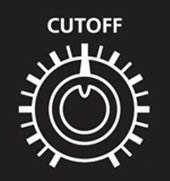
CLOCK – A PULSE WAVEFORM that can be used to determine a rhythm of a song, typically measured in beats per minute (BPM).
COARSE TUNE – The adjustment of PITCH in semitone steps.
COMPRESSOR – A DYNAMIC EFFECT that “fattens” up a sound by increasing the overall volume of a signal and then ATTENUATING the PEAKS of that signal at a certain THRESHOLD.
CONTROL VOLTAGE (CV) – used by ANALOG synthesizers to control the OSCILLATORS, FILTERS, ENVLEOPES and other components. For example, using an LFO for CV gives you “hands-free” control over certain parameters like volume (tremolo), PITCH (VIBRATO) and CUTOFF (FILTER sweeps).
CREST – The top most peak of a sound WAVEFORM
CUTOFF – The FREQUENCY at which a FILTER starts to work.
CYCLE – In a sound wave, the repeating movement from the greatest amount of air pressure to the least; the PITCH of sound waves is measures in cycles; each cycle equals one “Hertz.”
D
D-BEAM – A realtime controller found on many Roland instruments. You can manipulate or TRIGGER sounds by moving your hand above the D-Beam
DATA – The information that is processed by a computer/microprocessor. It is stored in an ADDRESS.
DCO – Digitally Controlled OSCILLATOR – An ANALOG oscillating circuit controlled and monitored by a digital microchip. Used in the JUNOs and JX- series, DCO’s were favoured due to their stability, providing an accurate, self-tuning analog sound in a synth.

DECAY – The second stage in the standard ADSR ENVELOPE. Decay describes the behaviour of the sound immediately after the initial striking of the key.
DEFAULT – A start-up value for parameter, ie, the value given before any programme specifications have been made.
DELAY – An effect in which a copy of a signal is played back later than the original which can give anything from a subtle repeat to thicken up a sound, to a cavernous echo. There are many types of delay such as digital, analog, tape etc.
DETUNING – This describes the effect heard when tuning one OSCILLATOR sharp or flat in respect to a second oscillator. This produces a fattening of the sound or it may produce a harmony effect if the interval of the tuning is wide enough.
DIGITAL – In synthesis terms, sounds are stored as a binary code (of 1’s and 0’s called a sample) then converted to an analog signal by a Digital to Audio Converter (DAC) inside the synth. Digital synthesizers are stable in PITCH, offers lots of MEMORY for presets and can offer much more control over the sounds it can generate.
DIGITAL AUDIO WORKSTATION (DAW) – A computer recording system. Often refers to the software which a computer runs to record audio and MIDI.
DISTORTION – An effect originally created by sending too much voltage through an AMPLIFIER valve or transistor. Many different types of distortion can be created depending on the strength of the effect ranging from overdrive to metal distortion.
DIN Sync – A form of TEMPO and start/stop SYNCHRONIZATION used by Roland drum machines and synthesizers (including the TR-606, TR-808, TR-909, TB-303, and MC-202).
DSP – “digital signal processing,” the means by which DIGITAL audio is mixed, FILTERED, EQUALIZED, or by which effects are added.
DUOPHONIC – A synthesizer that can play two notes or sounds at the same time. A duophonic synth features two independent synth blocks (a block contains independent OSCILLATOR, FILTER/S, ENVELOPE/S and AMPLIFIER).
DYNAMIC – The range of volume in an audio signal, soft to loud. Can also refer to the strength at which you play an instrument or markings on written notation indicating how to play a note or group of notes.
DYNAMIC RANGE – The amount of control a touch responsive KEYBOARD, or controller, gives the player.
E
EFFECTS – A modifying audio process that takes an original signal and overdrives (DISTORTION), modulates (FLANGING, phasing, CHORUS) or applies a spatial quality (REVERB, DELAY). Typically abbreviated to “FX”.
EMPHASIS – See RESONANCE.
ENVELOPE – A WAVEFORM that changes over time. Envelopes require a TRIGGER or GATE (typically from pressing a key on the keyboard) which then controls the volume of an AMPLIFIER and/or the tone of an OSCILLATOR (via filter CUTOFF).
EQ (EQUALISATION) – The process of altering the levels of FREQUENCIES that comprise a signal. In synthesizers (the Roland D-50 excepted), there is no EQ section as such, since the filters perform all the tone control tasks. Electric pianos, however, can have a three-band EQ (treble, bass and middle controls).
EXPANSION BOARD – An optional circuit board installed in a device to add additional sounds or EFFECTS processing.
F
FEEDBACK – The routing of some of the output of a device back to its input. In FILTER terms, this results in an increased RESONANCE.
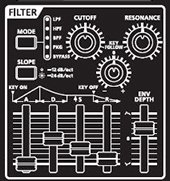
FILTER – A circuit that eliminates certain HARMONICS from the sound generated by the sound source (the VCO, DCO etc), and allowing the rest to pass (refer to LOW PASS, BAND PASS, HIGH PASS). Using a filter/s to reduce harmonics provides TIMBRE or colour to the sound.
FINE TUNE – The adjustment of PITCH in the smallest of increments, typically 100ths of a semitone, or “cents.”
FLANGER – An effect that generates a swirling sound by adding a slightly delayed copy of the signal in which the copy’s DELAY time fluctuates.
FREQUENCY – Refers to the number of times per second that a sound wave’s cycle repeats, with a greater frequency resulting in a higher perceived pitch; also used as shorthand for describing sound waves in audio by their pitch.
FUNDAMENTAL FREQUENCY – the lowest FREQUENCY of a periodic WAVEFORM. an instrument playing at concert A has a fundamental frequency of 440Hz
G
GAIN – Another term for level.
GATE – A signal that can turn on and off; ON when holding down a key, OFF when releasing the key. A gate signal can turn a note on or off, change the stages of an ENVELOPE or start/stop a SEQUENCE. Can also refer to a DYNAMIC effect that cuts off a sound below a certain decibel level.
GLISSANDO – A fast run of notes. On a keyboard, the synthesizer automatically adds semitones between the first and second keys played.
GLIDE – see PORTAMENTO.
H
HARMONICS – specific OVERTONE FREQUENCIES that are generated by an instrument. Harmonics are found at intervals that are equal to the FUNDAMENTAL FREQUENCY. for example harmonics of a 20Hz tone will be found at 40Hz, 60Hz, 80Hz and so on.
HIGH PASS FILTER – A FILTER that allows only high frequencies above the CUTOFF to pass and eliminating low frequencies.
HOLD PEDAL – A pedal that, when pressed, causes sustaining notes to continue to play until the pedal is released.
I
I/O – Abbreviation for “in/out,” as in “inputs and outputs.”
K
KEYBOARD – A set of keys in order of ascending pitch as found on a piano, organ or synthesizer.
L
LAYER – Distinct tones or instruments played simultaneously to create an overall dense sound.
LCD – For “Liquid Crystal Diode’ or ‘Liquid Crystal Display’, a plasma-based display used in some instruments.
LEVEL – A general term for volume or AMPLITUDE.

LINE LEVEL – The high-level signal produced at the outputs of audio equipment such as synths, SAMPLERS, drum machines, MIXERS etc.
LINEAR ARITHMETIC SYNTHESIS – A form of synthesis that combines SUBTRACTIVE SYNTHESIS with PCM-based samples. LA synthesis is all DIGITAL (linear) and a summing (arithmetic) of sounds and is an entirely different method of synthesis to frequency MODULATION.
LOOPING – A function to automatically restart a SAMPLE at the end of the sample’s cycle providing a continuous loop of audio.
LOW FREQUENCY OSCILLATOR (LFO) – An OSCILLATOR that moves so slow (low frequency) it is below the audible frequency range. At this frequency, an LFO of different rates and shape may be applied to add movement and expression to a sound. For example, you can MODULATE an oscillator’s PITCH to create VIBRATO, filter CUTOFF to create FILTER sweeps and VCA gain to create TREMOLO.
LOW PASS FILTER – A FILTER that allows only low FREQUENCIES below the CUTOFF to pass and eliminating high frequencies.
M
MEMORY – A storage process that allows you to program sounds (using RAM) or store presets (ROM).
MERGE – A combination of sequences.
MIDS – the BANDWIDTH of midrange FREQUENCIES that can be heard by the human ear commonly accepted as approximately between 400Hz to 5.2kHz.
MIDI – For “Musical Instrument Digital Interface”: The wiring and message protocol that allows musical instruments and other devices to communicate.
MIDI CLOCK – A form of MIDI-based SYNCHRONIZATION that transmits a rhythmic pulse from one MIDI instrument to another to keep the devices synchronized.
MIDI CONTROL CHANGE (CC) – A type of MIDI message assigned to a particular PARAMETER. When you send a value for a MIDI Control Change number, it sets the corresponding parameter in the MIDI device that receives it.
MIDI MESSAGE – An instruction transmitted from one MIDI device to another. Each MIDI message contains at least two numbers: one that identifies the type of message being sent, and one that represents a value for the selected type of message.
MEMORY CARD – A compact-sized card that can store PATCH, SAMPLES and other kinds of DATA. An SD card is used in the current Roland product line.
METER – A device that shows the level of a signal.
MIXER – Determines the level of respective multiple OSCILLATORS when summed together.

MODULATION (MOD) – A method that uses CONTROL VOLTAGE to add movement and expression to a sound. A VOLTAGE is applied by either a physical action or electronically. Voltage is applied to a parameter that then oscillates the signal’s PITCH, FILTER or GAIN. Physical actions such as MOD WHEELS and D-BEAM can also modulate the sound.
MODULATION WHEEL (MOD WHEEL) – A wheel located to the left of a keyboard that allows you to change PARAMETER values in real-time.
MODELING – A process that imitates the sonic characteristics of another instrument or device. Roland ANALOG modeling recreates the sound of synth waveforms, while tone wheel modeling captures the sound of classic organs. Roland’s advanced COSM modeling creates realistic emulations of popular and classic microphones, guitars, guitar amplifiers and studio reference speakers.
MODULAR SYNTHESIZER – A synthesis system comprised of self-contained MODULES – each one with a specialized function to produce and shape the sound. Examples of modular synthesizers are the Roland System 100M and System 700. Modules are manually linked together using patch cords and have the potential of an infinite possibility of sound.
MODULE – A keyboard-less MIDI instrument (see expander) that can be controlled by any MIDI keyboard, for example the Roland INTEGRA-7 Sound Module.
MONOPHONIC – A synthesizer that can only play one note or sound at a time.
MULTIPLE TRIGGER – A system whereby a new TRIGGER pulse is generated every time a new note is played, no matter if others are still being held.
MULTITIMBRAL – A device that can play more than one PATCH at a time, typically through the use of a performance or multitimbre.
N
NOISE – A source of random VOLTAGE fluctuations.
NOTCH FILTER – see BAND REJECT FILTER.
O
OCTAVE – the interval between any given FREQUENCY and it’s double or it’s half. for example the next octave up from Concert A 440Hz is 880Hz. To the human ear, an octave sounds like the same note but at a higher pitch.
ONE SHOT – A single event that has to be triggered everytime it is required.
OSCILLATOR – A circuit that generates a signal with a FREQUENCY in the audible range. This is the core of a synthesizer. A synthesizer can have one (MONOPHONIC), two (DUOPHONIC) or multiple (POLYPHONIC/PARAPHONIC) oscillators. Every oscillator can have a different WAVEFORM with each waveform having a distinct TIMBRE.
OVERTONE – any FREQUENCY that is present in a WAVEFORM that is higher than the FUNDAMENTAL FREQUENCY of that waveform.
P
PANNING – The left/right positioning of a signal within a stereo image.
PARAMETER – A setting whose value can be changed, manually or via CONTROL VOLTAGE.
PARAPHONIC – A ynthesizer in which all voices run through only one filter, amplifier and/or envelope generator. Note: technically all
MONOPHONIC synths are paraphonic but the term is most commonly used to describe multiple-oscillator (voiced) synths due to their unique treatment of multiple notes.
PATCH – a sound made up from a combination of OSCILLATORS and/or samples combined with FILTERS, ENVELOPES and EFFECTS that is pre-programmed into a synthesizer. This term is derived from older style ANALOG synthesizers that you had to physically patch together with cables to create a sound.
PEAK– In a WAVEFORM, the highest sound pressure levels.
PERFORMANCE FEATURES – parts of a synthesizer that are specifically designed for use in live situations. For example a PITCH or MODULATION WHEEL that is easily accessible for quick manipulation or quick select buttons for the most commonly used PATCHES.

PERIOD – the time in seconds that it takes a wave to complete a CYCLE. Period is calculated by dividing 1 by the frequency (a 5hz note has a period of 0.2 seconds)
PIANO ROLL – A form of MIDI notation commonly found in DAW software, allows a composer to mark in notes based on a graph with the X axis corresponding to time and the Y axis corresponding to notes as they would be found on a piano keyboard.
PINK NOISE – A type of signal NOISE that has equal power in BAND WIDTHS that are proportionally wide. Humans hear the same interval between 40Hz and 60Hz as 4000Hz to 6000 Hz. Because of this, Each OCTAVE has an equal amount of power. This noise is useful as a reference signal for calibrating speaker systems.
PITCH – See FREQUENCY.
PITCH-BEND – Controlling the pitch of a note after it has been played. Usually achieved with a MODULATION WHEEL, joystick, or AFTERTOUCH.
POLYPHONIC – A synthesizer that can play multiple notes or sounds at once.
POLYSYNTH – (see POLYPHONIC)
PORT – An access point, usually on the rear panel of an instrument, that allows the user to tap into the signal chain, or to inject or retrieve information or control signals from the instrument.
PORTAMENTO – When one note is played after another, the PITCH of the note sweeps up or down from the previous note. Usually
controlled by a knob that increases or decreases the speed of the sweep.
PRESET – A sound that is programmed as a default into a synthesizer’s MEMORY.
PULSE CODE MODULATION (PCM) – A method of recording (encoding) natural sounds and storing them as SAMPLES for editing like synthesized sounds.
PULSE WAVE – a WAVEFORM that is similar in shape to a SQUARE WAVE but instead of symmetrically switching between CREST and TROUGH in regular intervals, a pulse wave switches at a rate dependent on it’s PULSE WIDTH
PULSE WIDTH – The period in which a pulse wave switches between its crest and trough. Represented as a percentage (as an example 25% means that the pulse wave stays on the peak for 25% of the time before switching to the trough for the remaining 75%). The asymmetric waveform is commonly modulated (pulse width MODULATION) via an LFO to create a unique TIMBRE favoured for bass and lead synth lines.
Q
Q FACTOR – The BANDWIDTH of a particular band in an EQ. Higher Q factor values mean a larger bandwidth.
QUANTISATION – The rounding off of an ANALOG signal to the closest specified increment.
R
RACK MOUNT – a module that is built to a width of 19-inches with ears on the sides for bolting to a standard equipment rack. The Roland INTEGRA-7 is a good example of a rack mount unit.
RAM – Random Access MEMORY. On board DATA storage used for storing PATCH information or samples for quick recall while playing. Quite often this information will be deleted when a synth is powered off but some flash memory can store data even while powered off.
REAL-TIME – A recording method that allows you to play live while your synth records. This is opposed to step or programmed recording where you input the recording instructions before playing.
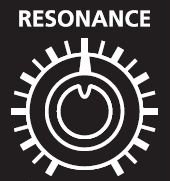
RELEASE – The fourth and last stage in the ADSR sound ENVELOPE, which describes how a sound varies with time. When the envelope controls the AMPLIFIER (VCA), the release is the time it takes for the end of the sound to reach its minimum volume.
RESONANCE – Achieved by applying FEEDBACK to a FILTER: the effect of resonance “boosts” the frequencies around the CUTOFF frequency. As resonance increases, the feedback increases to a point that the filter can generate a sine-wave tone. This is called “self-oscillation”.
RHYTHM – A feature of most home keyboards as well as some synthesizers and sound MODULES that allow you to play a selection of preset drum or percussion loops controlled by the instruments TEMPO function. Some instruments have functions for intros, outros and fills as well as the ability to change to more complex rhythm patterns.
RING MODULATOR – an effect where two WAVEFORMS are multiplied together with an output of the sum and difference of the frequencies present in each waveform. The effect is named for the metallic ringing timbre it creates
ROM – Read Only MEMORY. On board DATA storage used for storing PATCH and system information or SAMPLES . ROM data cannot be edited and will retain its information even while powered off. ROM Cards are often used to add sound libraries to a synthesizer or sound module.
S
SAMPLE – A digitally recorded sound which can be played via a synthesizer or sound MODULE.
SAMPLE RATE – the number of snapshots taken per second when recording digitally. These snapshots are indicators that a DIGITAL playback device uses to reconstruct a WAVEFORM. CDs store audio at a sample rate of 44.1KHz or 44,1000 snapshots per second.
SAMPLER – An instrument that allows you to record and play back SAMPLES. Some samplers allow you to stretch the PITCH of the sample across a keyboard.
SAW TOOTH – A WAVEFORM that is characterised by an instantaneous rise or fall and then a gradual linear incline or decline. The wave has a distinctive saw tooth shape.

SEQUENCER – an instrument, either hardware or software, that uses CONTROL VOLTAGES, GATE triggers and/or MIDI information to arrange events into musical patterns.
SCATTER – A Roland AIRA feature that exchanges steps in a sequenced loop to create an entirely new pattern. It also reverses playback of some steps and adjusts gate length (cutting off sounds earlier or later than programmed)
SIGNAL PROCESSOR – The section of a synthesizer or sound MODULE that generates and applies effects.
SINGLE TRIGGER – A TRIGGER pulse is only generated when all other keys have been released.
SINE WAVE – The simplest WAVEFORM which provides a pure tone. It is characterised by a repeating sideways S shape.

SLING-ON – A KEYBOARD that can be fitted with a strap for portable performance.
SPEC(S) – Specifications. A list of technical features
SPLIT – The ability to separate sections of a KEYBOARD at a set point so that one sound can be played on one side and a different sound on the other.
SQUARE WAVE – A WAVEFORM that is characterised by symmetrical uniformly abrupt changes between crest and trough. It is characterised by its square-like shape.
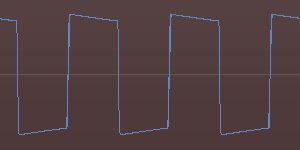
STATIC FILTER – A FILTER whose CUTOFF frequency is adjusted manually using the front panel controls, ie, it isn’t voltage controlled.
SUBTRACTIVE SYNTHESIS – A synthesis technique that uses filters to subtract frequency information from WAVEFORMS. Subtractive synthesis is commonly used by ANALOG synthesizers.
STEP SEQUENCER – A type of sequencer that allows you to program one note at a time into a limited number of beats or steps. When the sequence reaches the final step it reverts to the beginning of the sequence again unless it is deactivated or a new sequence is chosen.
SuperNATURAL– A roland proprietary SAMPLE based synthesis technology that models the sound and PERFORMANCE FEATURES of an instrument. Unlike regular PCM sampling, The SuperNATURAL engine doesn’t use sample looping and instead models the sound to react to performance DYNAMICS and nuances.
SUPERSAW – A WAVEFORM first featured on Roland synthesizers that uses one OSCILLATOR to create the sound of multiple SAW TOOTH WAVES DETUNED against each other.
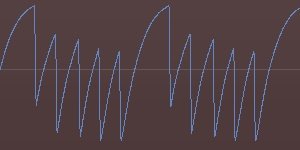
SUPERSQUARE – A WAVEFORM first featured on the Roland SYSTEM-1 synthesizer that uses one OSCILLATOR to create the sound of multiple SQUARE WAVES DETUNED against each other
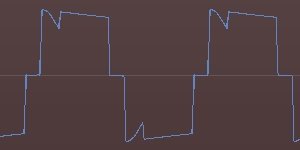
SUSTAIN – The third stage in the ADSR sound ENVELOPE, which describes how a sound varies with time. When the envelope controls the amplifier (VCA), the sustain is the volume that the decay will stabilise at while a key is pressed down.
SYNCHRONISATION – The locking in of TEMPO or CLOCK between different instruments to allow for precise timing when playing live. Or one OSCILLATOR locking onto a harmonic of another oscillator at different stages of its CYCLE. This provides the tone with complex HARMONICS and can sound brighter or more aggressive..
SYNTH PAD – A type of synth sound that is usually characterised by its ambient qualities due to its slow ATTACK and RELEASE times. Often used as a chord bed for other instruments to embellish.
T
TEMPO – The speed at which a piece of music should be played, measured in beats per minute, controlled by ANALOG or MIDI CLOCK
THRESHOLD – In DYNAMIC EFFECTS, the decibel level that must be passed before the effect activates.
TIMBRE –The aesthetic character and qualities of a sound. For example, a flute generally has a very smooth, hollow timbre.
TOUCH-SENSITIVE – A KEYBOARD or TRIGGER pad that responds to your playing DYNAMICS.
TRANSPOSE – The ability within a KEYBOARD synth or sound MODULE to adjust the key by shifting the notes that are played back in semitone increments. (for example if you transpose by +1 playing the middle C key will actually play a C#).
TREBLE – the BANDWIDTH of high end FREQUENCIES that can be heard by the human ear commonly accepted as approximately between 5.2kHz to 20kHz.
TREMOLO – a MODULATION effect that affects the volume of a tone.
TRIANGLE WAVE – A WAVEFORM that is characterised by a linear incline and decline. The Wave has a distinctive triangle shape.

TRIGGER – The method used to activate a sound from a synthesizer or sound module. A keyboard or drum pad are common examples of triggers.
TROUGH – The bottom most peak of a sound wave.
U
UNISON – two VOICES that are playing at the same PITCH
V
VCA – Voltage Controlled Amplifier: The synthesizer circuit that controls volume.
VCF – Voltage Controlled Filter: The synthesizer circuit that controls the filter CUTOFF.
VCO – Voltage Controlled Oscillator: The synthesizer circuit that controls an OSCILLATORS PITCH. By alternating the voltage fed to the circuit, WAVEFORMS can be created.
VELOCITY-SENSITIVE – See TOUCH-SENSITIVE.
VELOCITY – A MIDI data type that responds to the DYNAMIC ATTACK of a TRIGGER press. This typically controls volume.
VIBRATO – A MODULATION effect that affects the pitch of a tone, Creating a wavering or warbling effect.
VOICE – sound created by a single OSCILLATOR or oscillator group. The number of voices affects how many notes can be played simultaneously.
VOCODER – Voice Operated Encoder. A type of effect that makes your instrument appear to “speak” by taking an external audio source (usually a vocal microphone) and analysing the FREQUENCY BANDS which it then use to impose the characteristics of the audio source to the synth sound.
V/Oct – 1 volt per octave – A form of CONTROL VOLTAGE (CV) typically used in Roland, ARP, Oberheim, Sequential and Moog synthesizers.
V-TRIG – Voltage TRIGGER. Positive (+) gate trigger used in Roland, ARP, Oberheim and Sequential synthesizers.
VOLTAGE– A difference in charge between two points in a circuit. This difference, when combined with the rate of the charge (current) allows for the control of many ANALOG circuits that “synthesise” sound.
W
WAVEFORM – a graphical display of a sound pressure wave over time.

WAVE SHAPER – An effect that alters the shape of WAVEFORM to provide an output with complex HARMONIC character. This can be heard as formant-like sounds or abrasive, DISTORTION-like effect.
WHITE NOISE – A type of signal NOISE that has equal energy at any BANDWIDTH of frequencies when measured in Hz. ie. the amount of power at 20 – 60Hz is the same as at 450 – 490 Hz as both bandwidths are 90 Hz wide. Commonly produced by noise generators in Synthesizers.




